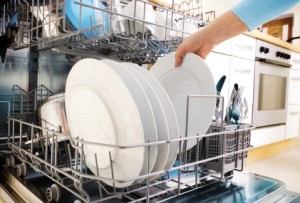MYTH #1
Dishwashers Fill Up with Water (Like a Traditional Washing Machines)
Anyone who opens their dishwasher door in mid-wash will see a surprisingly small amount of water – less than a bowl-full in the base of the machine. This is because a dishwasher actually cleans and reuses small amounts of water to be ultra-efficient.
MYTH #2
A Dishwasher Doesn’t Clean Pots, Pans And Cookware Properly
Heavily soiled items like pots, pans and cookware should be washed in an intensive cycle with higher temperatures. Together with Fortune 5-in-1 tabs, even the toughest stains like grease and baked-on food will be removed.
Fortune 5-in-1 tabs contain powerful stain-soaking enzymes. The enzymes are active early in the cleaning cycle when the lower temperature (< 122°F) creates the right conditions to break down baked on stains. This means you don’t need to pre-wash those tough-to-clean dishes like lasagna or oatmeal.
MYTH #3
A Dishwasher Uses A Lot Of Energy And Water
A recent study showed that washing dishes by hand uses more energy than using a dishwasher. The electricity in a dishwasher is used to heat up the water, which is pumped and recycled around the machine. The less water used, the less electricity is needed to heat up the water.
Compared to washing dishes by hand, dishwashers use much less water. A modern dishwasher needs about seven times less water than washing by hand. Dishwashers also heat up the water in a very efficient way by using a continuous-flow heater, which results in less heat loss than heating water in a tank and transporting it to the sink. In addition, the appliance is insulated to avoid heat losses from the interior space.

MYTH #4
Your Delicate Glasses Get Damaged In The Dishwasher
Glassware is generally suitable for the dishwasher. However, depending on the type of glass and the conditions in the machine, in a few instances the glass may become cloudy. A fundamental distinction can be made between two different clouding effects on glass:
1) Lime deposits: These are caused by hard water buildup, and can easily be removed by rubbing with vinegar. To prevent lime deposits in the future, please ensure that your water softener unit is set correctly, and that you are using a quality detergent such as Fortune Active Detergent and a rinse aid such as Fortune Rinse Aid.
2) Glass corrosion: Glass corrosion is a form of damage to the glass, which cannot be reversed. It is caused by the washing-away of the surface of the glass. Poor glass quality, extreme soft water in the dishwasher, as well as high temperatures and long program cycles are critical factors in the occurrence of glass corrosion. The following tips should help you to prevent corrosion to your glasses:
- When buying glasses, pay attention to whether they are dishwasher safe.
- Ensure that your water softener unit is set correctly.
- Only clean your glasses at low wash temperatures, e.g. in glass/gentle/delicate / quick programs
- Once the wash program is completed (after drying), open the dishwasher door briefly and allow the steam to be released. This is not necessary if your machine is equipped with a drier fan. Only remove glasses once the machine has cooled down.
- Ensure that the rinse agent setting is adequate.

